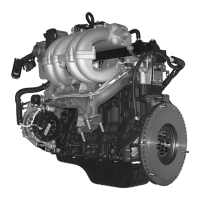TP-6903 5/16a Electrical System and Sensor Troubleshooting 67
4.6. Fuel Control Valve
Troubleshooting
Figure 4-10 Fuel Control Valve, KG2204
Figure 4-11 Fuel Control Valve, KG2204T
WARNING
Explosive fuel can cause fires and severe burns.
If a gaseous odor is detected, ventilate the area and
contact an authorized service technician.
LPG (Liquefied Petroleum Gas) is extremely
flammable and tends to settle in low areas where a
spark or flame could ignite the gas. Do not start or
operate this engine in a poorly ventilated area where
leaking gas could accumulate and endanger the safety of
persons in the area.
NG (Natural Gas) is extremely flammable, is lighter
than air, and rises. Do not start or operate this engine in
a poorly ventilated area where leaking gas could
accumulate and endanger the safety of persons in the
area.
To ensure personal safety, installation and repair of
LPG/NG fuel supply systems must be performed only by
qualified LPG/NG system technicians. Improperly
installed and maintained LPG/NG equipment could cause
the fuel supply system or other components to
malfunction, causing gas leaks.
Observe federal, state, and local laws governing LPG/NG
fuel, storage, and systems.
Figure 4-12 Fuel Control Valve Wiring Diagram
Refer to Figure 4-12 and follow the steps in the
troubleshooting chart to verify that:
The fuel control valve is working correctly
The fuel control valve leads have continuity
(no open circuits).
The fuel control valve leads are not shorted.
P26-22, Fuel control valve
Fuel
control
valve
Power from
the controller
P26
65
Powe
1
2
70J
22
70H
ECM

